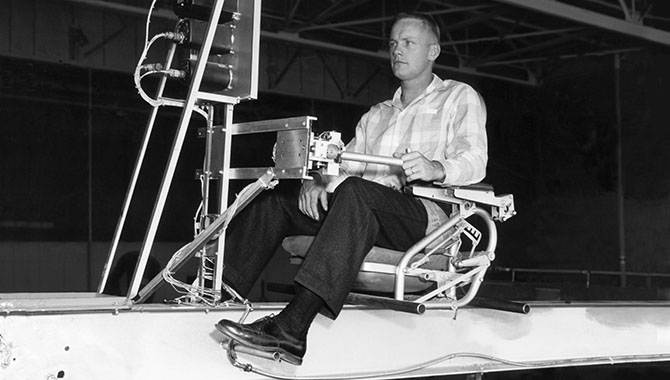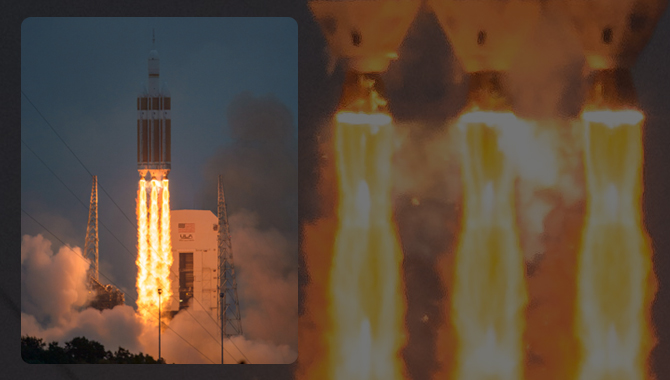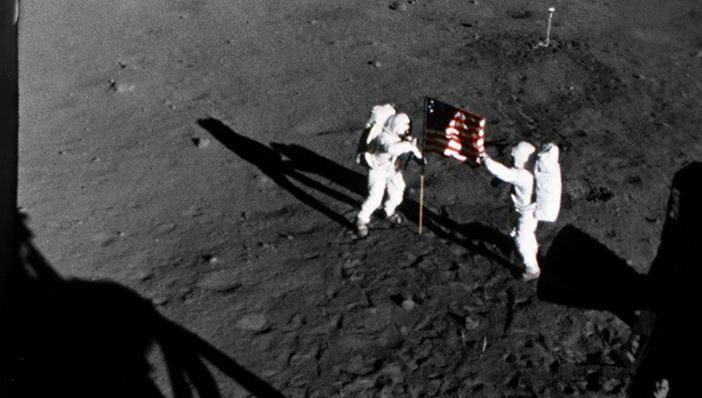
Astronaut Neil A. Armstrong, the first man to set foot on the moon during the historic Apollo 11 space mission in July 1969, served for seven years as a research pilot at the NACA-NASA High-Speed Flight Station, now the Armstrong Flight Research Center, at Edwards, California, before he entered the space program. Armstrong is pictured here on an early simulator, dated October 8, 1956.
Photo Credit: NASA
In the movie Edge of Tomorrow, Tom Cruise’s character is stuck in a time loop, which—after his violent death by earth-ravaging aliens—returns him to yesterday only to fight another day until he dies again.
The line, “Live, Die, Repeat,” was used so heavily in the film’s marketing, some movie-goers confused it for the actual title of the film.
Some critics touted the Cruise-vehicle as Ground Hog Day meets Starship Troopers. Like Ground Hog Day, there is a love interest (Emily Blunt as super-soldier), and the narrative arch is the character’s learning curve of capturing and applying knowledge through trial and error. This déjà vu subgenre of science fiction has a prescribed rule for film-makers: if the hero makes the same mistake twice, then the audience will lose patience with the story.
Other critics have dismissed Edge of Tomorrow as just a single-player video game where an untrained character is “respawned” (a term from the gaming world’s ever expanding lexicon) until he gains enough skills to save the world. This criticism is fair enough, but it is certainly missing the fun of the flick and perhaps missing a larger point. The invading aliens—long before attacking earth—have mastered some kind of “temporal reset” that allows them to replay battles to learn how to win them. Cruise’s character has inadvertently hacked into this reset command. He can play until (while still hacked in) he learns enough to win. In a word, the movie is about gamification.
Gamification is a relatively new word. Some word processors underscore it with a red line. Gamification is generally used to describe situations where game devices, rules, or elements are used in non-playful activities—usually learning activities—not typically associated with gameplay, namely the workplace. NASA has used a similar word much earlier in the IT learning nomenclature: simulation. No red line here. In fact, NASA’s Ames Research Center is a world leader when it comes to the art and science of simulation. Many an astronaut and a gamer have appreciated a realistic flight simulator.
But aspects of simulation can differ from gamification. “Gamification can use player competition and rewards for accomplishing desired tasks in order to more fully engage participants in a process,”says Michael Bell, Chief Knowledge Officer at Kennedy Space Center.
Bell states, “We use simulations and technology every day for learning and improvement. For example there is a speed camera lottery in Sweden which compelled motorist to play the game and drive safely.” Motorists are given positive incentives to check their speed and have fun doing it, as compared to the negative of a speed camera. Another film example of this is in the futuristic short film Sight, where the main character uses an App to help him on a date. Eventually his date finds out that he is keeping score and angrily leaves! Obviously, games need buy-in from all players.
To help map out the uncharted waters of gamification, Bell facilitated at the Federal Knowledge Management Community meeting on January 23rd an interactive exploration of using gamification techniques to incentivize knowledge sharing services and activities. The conversation drew from community members’ experiences—their successes and challenges—around the potential of gamification. Central to the conversation were: 1) What does or what could gamification look like when applied to knowledge management? 2) What motivates employees to share knowledge and engage in other knowledge activities? and 3) What are or what would be the pros and cons of incentivizing KM?
A NASA@work challenge is a successful example of gamification at NASA. NASA@work is a platform that provides the opportunity for obtaining solutions from employees across the Agency for solving important internal business challenges. For each challenge, the “Challenge Owner” may select up to two winners from the submissions received from solvers. Winners can be Civil Servants or Contractors, and awards are determined based on a documented Reward System. A NASA@work challenge is being created to seek ideas on how to promote knowledge sharing through a knowledge sharing contest.
By sharing our experiences in these early days of applying gamification to knowledge services, as knowledge practitioners we can learn not to make the same mistakes twice. Gamification has proven to be an established and very successful tool for knowledge and learning. We will continue to explore its benefit and exploit its power. Still, we must diligently ask questions to enhance its uses for NASA.
Emily Blunt’s character in Edge of Tomorrow asks, “What do we do now?” And Tom Cruise’s character replies, “I don’t know… we’ve never gotten this far.” The audience knows they have to play to win.









